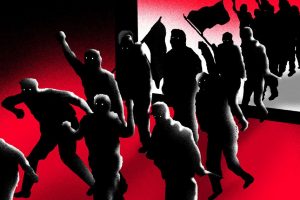Capitol Riot Broke Social Media, and the Effects Will Be Lasting

LISTEN TO ARTICLE
SHARE THIS ARTICLE
The tweet on Jan. 8 that ultimately pushedTwitter Inc. to ban its most high-profile user didn’t look much different from thousands of others Donald Trump had sent during his presidency. Two days earlier the social network had removed a video rant in which he repeated baseless claims of election fraud and told armed rioters in the U.S. Capitol that he loved them. Using Twitter to tell the 75 million “American Patriots” who made up his political base that they would “have a GIANT VOICE long into the future” was mild by comparison.
But Twitter had warned Trump that another rule violation would lead to a ban. So after a presidency spent using the network to move markets, promote conspiracy theories, and threaten war, Trump’s violation on Jan. 8 of the company’s “Glorification of Violence” policy was the final straw. Over a 48-hour stretch he was also blocked or suspended from almost every major social media channel—including Facebook, Instagram, and Snapchat—and kept from using the e-commerce platform Shopify to sell his signature red hats and other merchandise.
The efforts were designed to limit the rhetoric that had inspired a mob to mount a violent attempt to overturn the results of November’s presidential election. Twitter said the way Trump’s followers interpreted his messages was as important as the wording itself, citing plans percolating online for them to commit more violence in the near future.
There’s some evidence that shutting down Trump had an immediate effect on internet life. Media Matters, the liberal-leaning media advocacy group, found that interactions with right-leaning pages dropped in the aftermath ofFacebook Inc.’s temporary ban. Right- and left-leaning posts drew roughly equal amounts of engagement after the ban, the group found, reversing a long trend of right-wing content outperforming other political content. “This data shows what the impact of removing him permanently from Facebook could be,” Media Matters wrote.
But even if Trump does disappear from the internet—or U.S. political life—his impact on social media is unlikely to dissipate so easily. Experts say his vast network of supporters will be energized by the bans. “It does make him a martyr,” says Marc‑André Argentino, a researcher and noted observer of QAnon, apro-Trump conspiracy movement based on the conviction that the president is fighting an international cabal of sex traffickers who dominate world politics. Twitter’s ban has confirmed for QAnon followers that tech platforms are part of this conspiracy of elites, Argentino says. Their communities may have relied on mainstream social media services to form, but they’re less vulnerable to crackdowns now that they already exist.
The last year of intensifying debate about the parameters of speech on mainstream social media platforms has given rise to new ones for conservative speech. TV networks that provide willing audiences for Trump’s surrogates and so-called alt-tech platforms have been falling over themselves to provide a home for the extended “Make America Great Again” community. Trump has “a whole team of demi-media sycophants who are catering to his audience,”tweeted Renee DiResta, a research manager at the Stanford Internet Observatory, shortly after the company banned the president.
The social network Parler emerged in 2020 as the prime destination for right-wing users who felt alienated by Facebook and Twitter, and it rode their anger to become the most downloaded app inApple Inc.’s store immediately after Facebook and Twitter suspended Trump. Then Apple and Googlesuspended Parler from their app stores, and Amazon Web Services said it would no longer provide technical infrastructure, forcing Parler to shut down at least temporarily. All of the companies cited Parler’s inability or unwillingness to remove posts calling for or glorifying violence.Parler has sued AWS, accusing it of acting anti-competitively.
With Parler down, QAnon groups on Gab, another social network that caters to the far right, saw a surge in membership, with the largest group growing by more than 50,000 members, according to Argentino. A channel on Telegram, the messaging app, dedicated to “Parler refugees” had more than 16,000 members as of Jan. 11.
If these sites become durable alternatives to mainstream ones, the migration could aggravate trends that predated Trump, says Genevieve Lakier, a First Amendment law professor at the University of Chicago Law School. “One of the consequences of this might be further fracturing of our public discourse,” she says, “so that Twitter becomes the place for certain groups and certain voices, and then other social media sites like Parler or Gab become a site for others.”
It’s not a sure bet. Facebook and Twitter appeal to political agitators because they draw a large number of less political users who can serve as an audience. Facebook has noted repeatedly that many of its users spend little or no time interacting with political content. The users of alt-tech sites, by contrast, are relatively like-minded, so agitators have few people to argue with or recruit.
So far, alt-tech sites don’t have the scale they’d need to threaten mainstream social media. But the eleventh-hour crackdown on Trump may weaken the internet giants in another way. The demonstration of their power has raised concerns even from the president’s critics, such as the American Civil Liberties Union and leaders in Germany and France.
In the U.S. the insurrection at the Capitol has given Democrats who want Facebook and Twitter to more actively police their networks a real-world example of what happens when that policing fails. Republicans who think tech companies wield too much power have watched Silicon Valley deprive a sitting U.S. president of his preferred method of communicating with the public.
Trump’s recklessness online may be what finally creates regulations for an entire industry, Lakier says. “Trump has played this really amazing lightning rod role in focusing attention on those questions,” she adds. “The timeline has been sped up.”
Source: Read Full Article
